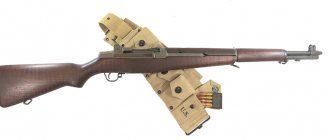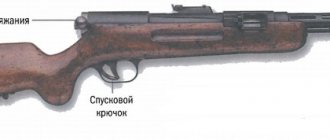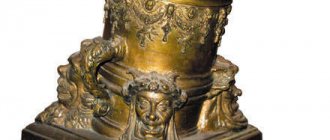Firearms
generally refers to any weapon that uses gas pressure from rapidly burning substances (such as gunpowder) to propel projectiles. It is divided into small arms (carried in the paws of people, small caliber) and guns (installed in fortifications or on military equipment, large caliber). It is usually considered that the boundary between small arms and artillery calibers is 20 mm (2 centimeters), but there are exceptions in both directions; for example, tank machine guns (7.62 or 12.7 mm caliber) are bolted to the tanks, and the Mechem NTW-20 rifle (20 mm caliber), despite the artillery caliber, is hand-held.
"Cannon" castle[edit]
Beginning of the 15th century: a knight and two Hussites with a firearm (one holds a primitive hand grip mounted on the end of a spear shaft, the other brings a fuse to it)
The first small firearms appeared a short time after the first firearms artillery, and were not much different from it. These so-called “hand-held guns,” or hand bombards, were essentially very small cannons that could be carried by one person. The short trunk was attached to the end of a stick with a hook; the opposite end of the stick was held under the arm, and the hook clung to some support to hold the recoil. The “cannon” lock was a simple hole in the breech - the back of the barrel. Something burning was brought to the hole, the gunpowder ignited and the handgun fired. Yes, it was, in fact, an arson, similar to the ones you or your fathers made when you were at school - only bigger. One handle consisted of two people: one held it, the other set it on fire. The handgun fired round lead bullets, very inaccurately and not too far, and was only at all effective in the case of volley fire. However, most of the subsequent models of small arms also had this sad trait. The Hussites were the first to use hand cranks in Europe.
How the first guns were fired
Shooting from handguns in the 15th century. Illustration from the book “Rudimentum Noviciorum”, published in Lübeck. Hand grips are attached to long shafts and equipped with seed holes
The metal trunks of the Tannenberg handbrake and the Morco handbrake are about 300 mm long. The bore diameter is about 17 mm. There was a powder chamber in the handgun, to which a narrow seed hole led, drilled at right angles to the barrel. Gunpowder and a shell were placed in the barrel. To fire a shot, a hot wire was probably inserted into the seed hole. Another method was to use a smoldering wick. The wick was usually made from twine soaked in a solution of potassium nitrate and then dried. When lit, such a wick burned slowly at a predictable rate.
It is believed that a bullet fired from a handgun could pierce the steel armor common at that time at a moderate distance. In addition, the roar of the shot and the bright flash should have had a strong psychological effect on the enemy. Do not underestimate the effectiveness of this relatively primitive weapon.
Antique hand cannon from Wedelspang Castle in Copenhagen. This long, thin hook, dating from around 1400, was probably more effective when used as a club
Matchlock[edit]
The first lock, more complex than the splinter hole, was nevertheless quite simple. The hole in the breech began to open onto the shelf
, which, in essence, was a shelf filled with fine gunpowder. Nearby, a serpentine was attached to the stock of the gun - an S-shaped piece made of thick iron wire. One end of it was a trigger, and a smoldering wick was attached to the other. When the hook was pressed, the serpentine lowered, the wick touched the gunpowder on the shelf, it flared up and ignited the gunpowder in the breech, and a shot was fired.
The first real guns equipped with this lock were called arquebuses (from the name of the crossbow that fired bullets), or in other words, hackenbooks (from the German “gun with a hook”). Hooks, however, were preserved only by the heaviest arquebuses, the so-called serf guns (in Rus' - zatinny arquebuses). Ordinary arquebuses did not have hooks; their bullets were capable of piercing many types of armor, but they did not take full plate armor.
It was then that something averaged between a serf and an ordinary arquebus appeared: a musket, that is, a long, heavy, large-caliber arquebus, from which they shoot from a support, but without a hook. The musket did not need a hook, because it already had a full-fledged butt, which allowed the shooter to take the recoil with his shoulder; but the musket still kicked like a wild horse. Musket bullets could already with considerable probability penetrate almost any armor, except the heaviest and impractical in battle.
The musket was the first practical weapon suitable for mass use on the battlefield, and gave birth to a new, widespread type of infantry: the musketeer. The life of most of them was by no means as glamorous as that of the royal musketeers glorified by Dumas: a simple musketeer, hung with charges and smoking fuses, stood at full height on the battlefield in the ranks of the same unfortunates and tried in vain to aim from his oblique bandura at least anywhere something into the enemy formation. When the first line of musketeers fired a volley and mowed down a number of enemy soldiers, it went back and gave way to the next line of fire; The musketeers who had fired and ran back were feverishly trying to reload their huge and inconvenient pipes. To do this, it was necessary to carry out a whole sequence of actions: pour gunpowder from the flask into the barrel, push and spray the bullet, pour the gunpowder onto the shelf and all the time make sure that the fuse does not go out; If it goes out, use the spare one to light it. The next line fired a volley and went back, and so on. This formation was called "caracol", from the Spanish "snail". And if the cavalry reached the musketeers’ caracole, then it’s all lost: they, of course, could somehow fight off the muskets with their sharp supports, but it was still better to hide behind the wide muzzles and close ranks of pikemen, more than capable of stopping a cavalry attack .
Wheel lock[edit]
Only a little later than the matchlock, in the 16th century, a more complex and advanced lock appeared: the wheel lock. It was cleverly designed, like a wind-up toy: a spring pulled a chain wound on a wheel, which rubbed against the pyrite and struck sparks from it, and these sparks ignited the gunpowder on the shelf. This made it possible not to steam with any wicks, but simply point the barrel and fire. But such a lock was expensive, and there was no question of mass rearmament of musketeers with wheel locks.
But the wheel lock gave birth to a new weapon: a pistol, or pistol. It became possible to carry a small, one-handed weapon with you all the time and shoot whenever you want, and not just on the battlefield. The pistol was especially loved by cavalrymen, among whom a new branch of troops appeared: reiters. They, instead of rushing up with knightly spears, began to fire at the enemy with pistols as they galloped. The Reitar pistols were special and were called Reitpistols: they were longer, more powerful and more expensive than ordinary ones, sort of like the “Magnums” of their time.
It is the German reiters who have the honor of the first attempt to create a multi-shot pistol. After all, it’s better to carry one or two multi-shot pistols into battle than a whole arsenal of single-shot pistols! The majority followed the simple path and simply made double-barreled pistols. But some went further and ordered themselves four-barreled, or more complex designs: the first primitive revolvers with a manual rotation of the drum, or designs like a Roman candle, with several layers of “gunpowder-bullet” in one barrel.
Another innovation ahead of its time brought by the wheel lock was the rifle, or as it was then called, the screw lock. The rifle hit much further and more accurately than the musket, thanks to its rifled barrel, which spun the bullet like a top when fired; it was already possible to meaningfully aim from it. The first rifles had many disadvantages that did not allow them to be used on the battlefield in any significant quantities: firstly, they were made very labor-intensively, by hand, and were extremely expensive; secondly, in order to load the wheel fitting, the bullet had to be hammered into it with a hammer for five to ten minutes. Therefore, fittings initially became widespread only as a hunting weapon for wealthy gentlemen, and only a couple of hundred years later, after the mass distribution of the flintlock, they would begin to arm individual elite units - the so-called huntsmen.
Another novelty of those years, which became quite popular, was a gun called a tromblon, or a blenderbass, or a blunderbuss. It was the world's first shotgun, also known as a shotgun. The bell at the end of the barrel made it possible to easily pour shot or buckshot into it directly in the saddle on a horse or while hanging on the mast. The tromblon made it possible to forget about the low accuracy of the musket, because it compensated for this by scattering the shot. These shotguns gained popularity among sailors, hunters, and mail coach guards, and were used to a limited extent by the military.
An interesting “spin-off” of the wheel and flintlock technology was the flintlock pistol. It was such an old, elite and expensive lighter, similar to a small pistol without a barrel (and often a pistol that had served its purpose and been converted). Although it did not have a barrel, the shelf was large and filled with flammable and long-burning materials (for example, a waxed candle wick coated with gunpowder could be placed there). When the trigger was pressed, sparks ignited the gunpowder on the shelf, which ignited the wick, and the owner of the lighter could light the pipe. Of course, after each strike with such a lighter, you had to start it again with the key (if it was wheel-type) or cock it (if it was flint-type), and re-load the shelf with wick and gunpowder. A distant descendant of the flint pistol is the now well-known gas lighter in the form of a pistol, which, like a genuine modern pistol, is magazine-operated and semi-automatic, and only needs to be charged from time to time.
Explanation of some firearms terms that the MTA gets confused with[edit]
Caliber[edit]
Barrel diameter. There are three caliber measurement systems.
- Metric (denoted by the letters “mm”, that is, millimeter) is the simplest, measuring diameter in millimeters.
- Inch (indicated by a dot before the numbers, for example .38) - a measurement of diameter in fractions of an inch. For example, .357 means 0.357 inches, or 9 mm. In Tsarist Russia, the inch system was also used, but with a different notation: the caliber was measured in tenths of an inch, or lines. For example, a “4.5-line revolver” is the same as a .45 caliber revolver. It should also be noted that .38 and .357 calibers are the same, but with different case lengths; the same about .45 and .454; The length of the cartridge case is usually not indicated in any way (the longer version of the standard cartridge is called magnum), but after the inch description of the cartridge there is the type of cartridge, for example .38 special, .45 long colt, .454 casull, etc. The specialist knows what is interchangeable with what , but the general rule here is that a cartridge with a shorter cartridge case length can be loaded into a magnum gun, on the contrary - NO, because, firstly, it will not fit, and secondly, it will tear the barrel, which is not designed for such power. In modern Russian artillery, calibers are an echo of the previously used inch system. They were simply converted from inches to millimeters. At the same time, the resulting numbers were rounded for convenience of notation. For example, a 76 mm gun actually has a caliber of 76.2 mm (3 inches), a 152 mm howitzer has a caliber of 152.4 mm (6 inches), etc. In common parlance the names have been preserved: “three-inch”, “six-inch”, etc.
- The rifle gauge is now used to measure the caliber of hunting rifles and other shotguns. In it we measure not the diameter of the barrel itself, but the number of round bullets that can be cast from 1 pound of lead. For example, a 12 gauge is a gauge that will accept a 1/12 pound round lead bullet.
Trigger[edit]
This is a hammer that hits the primer or the striker, which already hits the bottom of the cartridge. This is not a fucking trigger! Those who like to write “pulled the trigger” can be killed by their slipper against the wall. The correct spelling is “pull the trigger” or “pull the trigger” or “pull the trigger” (if the weapon has a trigger). But in order to cock it (again, if it exists), it is quite possible to “pull it back” or even “pull it”, if there is no time and the movements raising the revolver, cocking the hammer and “folding” the character into a cowboy stance are merged into one.
ATTENTION: on a wheeled pistol (or a musket or arquebus - which is rare but does happen) - pulling the trigger means releasing the safety, not firing! Because when firing, the wheel begins to rotate, striking sparks from the flint or pyrite clamped in the trigger and already lowered onto this wheel.
Ammunition[edit]
To fire, you need to have a set of a projectile, propellant charge and igniter. All this together, regardless of the specific form, is called a shot
.
The projectile
is what will fly towards the target.
A bullet
is a small projectile, usually for a handgun.
Propellant charge
- a certain amount of gunpowder with which the projectile is thrown out of the barrel.
The igniter
is what sets the charge into action: a primer, a rapid-fire tube, an electric igniter.
A cartridge
(in modern artillery it is called
a unitary shot
[2]) is a shot, all parts of which are connected into a single whole using
a cartridge case
.
- According to GOST, a bullet differs from a projectile in caliber (up to 20 mm) and the absence of a leading belt. Definitions may vary in other countries.
Important:
so-called
A “blank” cartridge is not a “cartridge in which there is no bullet,” as many inexperienced authors think, but a cartridge into which a small amount of gunpowder is specially placed during production. you can
shoot someone with it , but only if you shoot at point-blank range.
- Not certainly in that way. There can be the same amount of gunpowder or even more in a blank cartridge (to ensure the operation of automation or throwing a grenade), and instead of a bullet there can be a cardboard (felt, polyethylene, etc.) wad or nothing at all (just a rolled-up cartridge case). The 5.45 mm blank cartridges for the AK-74/RPK-74 contain a plastic bullet simulator (actually a wad, colloquially called that), which is destroyed when fired.
(bullet) - in real life: zhakan, an elongated bullet for a gun (instead of shot); in games this is the name of railgun ammunition.
(flechette) is a special ammunition for underwater shooting (looks like a nail without a head), as well as a feathered arrow mainly for experimental firearms (there was an idea to equip a shotgun cartridge with titanium arrows, but the idea was abandoned), of the serial ones on land it is used only by the Austrian large-caliber AMR (Anit-Material Rifle) sniper rifle, and almost all underwater firearms fire flechettes. During World War I, flechettes were poured out of boxes from airplanes as they flew over the trenches.
Artillery[edit]
gun
- a general name for artillery-sized firearms.
Different types of guns differ in their relative charge
= projectile weight/powder weight. Each type of fire can have any type of fire, given the appropriate design of the carriage, although the further away from the gun the worse the accuracy of flat fire. With the advent of guided missiles launched through the barrel, the BMP-3 gun, for example, began to be called the “Gun Launcher”.
- A cannon
is a weapon with the strongest propellant charge
(relative or absolute?)
. The cannon has the longest range and projectile impact force. - A mortar
is a weapon with the weakest propellant charge.
The range and impact force are very small. But with the same projectile, the mortar is much lighter. You can do the opposite - maintain the weight of the gun and give a heavier projectile (with more “filling”). Or choose something in between, gaining weight in both the projectile and the gun. Mortar
is the Russian name for a mortar, which instead of a carriage has a plate resting on the ground.
Such a mortar can only fire with overhead fire.[3]. In addition, there is a difference in ammunition. The mortar fires an ordinary artillery shell, as a rule, it is breech-loading and the propellant charge in it, either in a sleeve or in a cap, is placed in the charging chamber in the treasury. A mortar, as a rule, is muzzle-loaded, fires mines
similar to an aircraft bomb with a shank and tail (in English a mortar mine is called a mortar bomb, in Russian this name is assigned only to
over-caliber
mines), and its propellant charge is enclosed in the shank of the mine , and is also put on the shank in the form of ring-shaped bags-caps for reinforcement. In addition, the mortar has a regular artillery trigger, while the mortar has a primer placed in the shank, and at the bottom of the barrel there is a firing pin, which punctures the primer when the mine is lowered into the barrel.
is a special mortar for firing over-caliber bombs (that is, placed directly on the barrel of a relatively small caliber) bombs. They were popular during the First World War; subsequently, highly specialized bomb throwers fell out of use in the army, giving way to more universal mortars, which can also have an over-caliber mine among their ammunition, and remained only in the navy, where they fire depth charges[4].
— an intermediate option between a mortar and a cannon.
- Cannon-howitzer and howitzer-gun
are intermediate options between a cannon and a howitzer, with a predominance of the cannon and howitzer, respectively.
are weapons that have no recoil when firing. This effect is achieved by removing part of the powder gases through a special nozzle in the breech of the barrel, resulting in the creation of a reactive force that balances the recoil force. Recoilless rifles can be either rifled or smooth-bore; the latter are currently more common. Due to differences in terminology, they are often referred to as grenade launchers, for example the SPG-9 grenade launcher is essentially a recoilless rifle.
According to GOST, artillery is considered to be anything that has a caliber of 20 mm or more inclusive (and a leading band on the projectile). Anything less is a small weapon. In the West everything is complicated.
- Artillery can fire direct, semi-direct (separate) and indirect fire (from closed positions): Direct fire
- shooting at targets observed from a firing position, in which the gun is aimed at the target by aligning the optical axis (crosshair) of the panorama (mark optical sight) directly at the target. Those. the simplest type of shooting. Wherever I pointed, I ended up there. Tanks, anti-tank artillery, assault guns, grenade launchers, etc. For shooting at relatively short ranges, often at moving targets. - Semi-direct (separate) aiming
is a shooting method in which the shooter observes the target and points the artillery gun in a horizontal plane at it, aligning the optical axis (crosshair) of the panorama or the sight mark with the target, and aiming in the vertical plane is carried out as when shooting from closed positions . The same as in the first point, but at longer ranges. On moving targets - mainly in the form of barrage fire. - Firing from closed firing positions
is the conduct of artillery fire at targets that are not directly visible from the firing position. The exact opposite of direct fire. The main method of firing artillery. Theoretically, tanks can also shoot like this, but the dispersion when firing from smoothbore guns of modern tanks is too high and the effectiveness of such fire is quite low. Older tanks with rifled guns (T-34, IS-2, IS-3, T-55, T-10, etc.) are more effective, and earlier gunners and commanders were trained to fire with PDO.
It wouldn’t hurt to explain the types of fire - deck, mounted... what else is there?
Long-barreled hand weapons[edit]
Non-automatic[edit]
- A shotgun
is a long-barreled small arms with a smooth barrel (although the so-called anti-tank rifles were rifled, essentially anti-tank rifles). However, the gun can have very coarse rifling for firing Jacan - for example, w:Fosbury rifling and w:Lancaster rifling, while continuing to be considered a "smoothbore" due to the ability to fire shot. - A rifle
is a long-barreled small arms with a rifled barrel.
The rifling in the barrel spins the bullet so that, due to the spinning top effect, it flies straight and not obliquely. The fitting
is its muzzle-loading ancestor. Shoot the bullet through the rifling backwards! It was the loading speed that was its main drawback, to overcome which a lot of things were invented.
is a shortened and lightweight version of a long-barreled weapon. Until the 19th century, smoothbore carbines were common in cavalry, but since the 20th century, smoothbore carbines are no longer found, and all carbines are now only rifled. In the 19th century, there were also carbines that were a revolver with an elongated barrel and equipped with a butt.
Automatic[edit]
These types of weapons are described in detail in the article “Small arms chambered for a unitary cartridge.” Here - in brief.
- Automatic
- a carbine with automatic fire mode;
as a rule, by default it is assumed that this weapon is chambered for an intermediate
(automatic) cartridge (in the West, the term “assault rifle” is common in relation to such weapons), but not necessarily. For example… - A combat rifle
is an automatic carbine (the more common later version) or a full-fledged long-barreled rifle (an earlier, usually pre-war, and rarer version) chambered for a full-fledged rifle cartridge. They were actively developing before the Second World War, when SUDDENLY it turned out that it was cool, but impractical - the roads were difficult to master and maintain by soldiers, such a thing kicks during automatic fire worse than a machine gun, because it is much easier, so you can only get from it into the sky, only in Allah, and if we make it heavier to the point of controllability, then we get... we get a machine gun, a single one. As a result, an intermediate cartridge was invented, which made it possible to shoot at a target, and not at a white light, like a penny. The post-war approach to the projectile was rather caused by political reasons, or more precisely by the pressure of the Americans, who imposed their 7.62x51 cartridge on their NATO allies, which, although lightweight, was and remains essentially a full-fledged rifle. Nevertheless, two very successful rifles were adapted for it - the Belgian FN FAL and the German G3, of which this class essentially consists, but the conversion of the English EM1 to a much more powerful cartridge categorically spoiled it.[5] The term itself is a neologism from the 80s, invented when this class was already outdated. - ...A submachine gun
is a weapon similar to an assault rifle, but uses
pistol
cartridges.
Calling a PP a machine gun is a controversial matter: GOST believes that this is possible because it supports the tradition of naming the WWII, but no one else in the modern context calls a submachine gun a machine gun. During World War II, the term “machine gun” was quite firmly established in Russian terminology as applied to PPSh and PPS, and their carriers were called “machine gunner,” and in addition, submachine guns from WWII, especially PPSh, both in terms of weight-dimensional characteristics and tactics
applications were closer to modern machine guns than to PP (which, however, does not negate the first two letters in their abbreviations!) However, their performance characteristics and the pistol cartridge used clearly classify them (in the modern context) as submachine guns, i.e. if To be literal, the PPSh is a submachine gun that historically worked as an ersatz machine gun (and showed itself very well in this “ecological niche” - the lack of an intermediate cartridge was covered with a “Dakka”, because a thousand rounds per minute). - A machine gun
is a weapon designed for long-term automatic fire. General-purpose machine guns can be hand-held, mounted and single (allowing you to shoot both from a machine gun and from a bipod). There are also specialized ones: tank, aviation, anti-aircraft. At the end of the twentieth century, a special subclass of “light machine guns” was formed, like the Minimi, its American version M249 or the Russian RPK-16. Its essence is that there is no need for a second crew number and, accordingly, such a machine gun can be shoved into an infantry squad.
Flintlock[1][edit]
All the many advantages of the wheel lock were canceled out by one simple fact: it was an expensive pleasure. Therefore, in the 17th century they came up with a simpler, cheaper and more convenient replacement: a flintlock. In this castle, for the first time, such a detail of a firearm as a trigger appeared; here it was something between a hammer and a clamp, in which a flint was clamped, and the shelf acquired a specially shaped lid, against which the trigger struck a spark. The flintlock was an extremely successful idea: it was well suited for mass production and greatly increased the effectiveness of musket fire, even though the flint only lasted ten shots, after which it had to be hammered again, unlike pyrite, which was very slowly worn away.
A flintlock gun in English-speaking countries was usually called a musket, like a matchlock; In the Russian language, the word “fuzeya” (from the French fusil - gun) was established to designate it from the time of Peter the Great. Loading a fusée was about as cumbersome as loading a musket, but shooting from it was much more convenient: throw it up and fire, no fuss. Flintlock pistols became inexpensive and accessible to the masses. But the spread of the flintlock killed the Reitar: the fusiliers became numerous and made up the bulk of the infantry, and it was no longer difficult for them to shoot back from the arrogant horsemen. Pistols no longer gave cavalrymen the opportunity to shoot at infantry with impunity, like bottles. Therefore, there was a renaissance of bladed weapons in the cavalry, cuirassiers became more valuable again, and types of cavalrymen such as hussars and lancers (light cavalry, armed, respectively, with sabers and spears) became widespread. Cuirassiers relied on the strength of their armor, while light cavalrymen relied on speed.
By the way, why did the fusiliers make up the bulk of the infantry, where did the pikemen go? And they became unnecessary because it was at this time that the bayonet was invented. The first bayonet, the so-called baguinet, was a knife with a plug handle that plugged the barrel of a gun. It often fell out and did not allow you to shoot and stab at the same time. But at the end of the 17th and beginning of the 18th centuries, needle bayonets and cleaver bayonets appeared, attached to the side of the barrel: the descendants of these bayonets are still in use today.
Capsule lock[edit]
The flint castle reigned unchallenged for half of the 17th century and the entire 18th century. But in the 19th century, with the development of chemistry, a replacement appeared when scientists discovered the first highly sensitive initiating explosive - mercury fulminate. Now it was possible to abandon the shelf with gunpowder as an outdated and unnecessary phenomenon, and replace it with a tube on which the primer was placed. The trigger, now almost modern, hit the primer, causing a tiny explosion that ignited the gunpowder. In addition, the capsule gun, together with the simplification of the design (often replacing the trigger clamp with a hammer and screwing a fire tube into the barrel instead of a shelf), raked up a strong resistance to water, because the capsule completely sealed the gunpowder in the barrel.
Bullets from the mid-19th century.
The invention of the capsule made it possible to finally bring the revolver to fruition, and the American Samuel Colt became famous for centuries for his first practical multi-shot capsule revolvers, which created a sensation in the underdeveloped western states of the United States.
Another invention of the mid-19th century finally turned the rifle into a rifle, but it became tragic for Russia. I'm talking about the expansion pool. A bullet in the form of a hollow cone (Minié bullet for the French, Pritchett bullet for the British, etc.) was easily inserted into the barrel because it was slightly narrower than the caliber, and when fired it expanded and fit firmly into the rifling. This allowed the rifle to achieve the rate of fire of a shotgun, which was immediately tested in the American Civil War. The long-range effectiveness of rifle fire buried dense infantry formations forever.[2]
Boxlock[edit]
Travelers had an urgent need for a weapon of self-defense at close range (a vest pistol), and since compact weapons of this type did not exist in the flintlock era, they were invented. A boxlock pistol consists of a box body, inside of which the firing mechanism is located. The design feature is that the flintlock is located not on the side of the weapon, but in the center, inside the body. A little later, with the advent of capsules, the system was further reduced in size. The loading process is very unique - the barrel was unscrewed using a special key, gunpowder was poured into the breech and a bullet was placed, after which the barrel was screwed back. Simple, cheap and cheerful. With the advent of the unitary cartridge, it gave way to derringers, and until that time it competed with pepperboxes (for the pepperbox of those times was the same design, only with more barrels). Anyway,
, which very often had a short, but thick and rifled barrel, no one wanted: road pistols, as a rule, were made to accommodate a fuze charge of gunpowder and a fuze caliber. For the same reason, no one ever used these very accurate pistols for their size as dueling pistols, even when real dueling pistols were not at hand: these pocket mortars were too lethal.
A typical traveling nobleman carried two such travel pistols, rarely four. For this reason, the robbers of that time developed the habit of walking in groups of three.
The birth of a unitary cartridge[edit]
At the same time, another very important struggle was going on: for breech loading. The vast majority of older models of small arms were loaded through the muzzle, which was very inconvenient. And those that charged from the back, like the aforementioned Boxlock, charged even more inconveniently and slower. The capsule revolver was like a breech-loading weapon, but it cannot be said that the charging process was faster - you first had to remove the drum, then pour gunpowder into the chambers and hammer the bullets with a hammer, then insert the capsules and return the drum to its place. Therefore, many gunsmiths tried to invent weapons that could be loaded quickly.
Insert it into the chamber carefully so as not to dent it.
To speed up loading, they have long used ready-made measures of gunpowder in tubes with a lid, which musketeers carried on themselves like machine-gun belts. To load, they took the tube out of the tape, opened the lid, poured a little gunpowder onto the priming shelf, then poured the remaining measure of gunpowder into the barrel, returned the tube back to its place (the lid remained dangling on a string indicating that the tube was used), hammered a bullet with a wad into the barrel a ramrod and a hammer... - in general, all the convenience came down to having ready, precisely measured measures of gunpowder in the heat of battle, and not being afraid that you would accidentally pour too much from the powder flask and the barrel would break in your hands. Then paper cartridges appeared - a measure of gunpowder with a bullet wrapped in oiled paper. Initially, it was used like this: after biting the cartridge and holding the bullet with your teeth, you poured a little gunpowder onto the priming shelf, then poured all the gunpowder into the barrel and, using the paper from the cartridge as a wad, pushed the bullet in the old fashioned way with a ramrod. Then there were savvy soldiers who came to the conclusion that there was no need to pour all the gunpowder into the barrel, but it was easier, after pouring a measure of gunpowder onto the seed shelf, to push the entire cartridge with the bullet into the barrel as is. Which significantly speeded up the charging process, and then became part of the charter as a generally accepted practice. And finally, the Prussians came up with the idea of combining a paper cartridge with a primer. Moreover, the primer was initially placed inside (!!!) a paper cartridge next to the bullet, and in order to reach the primer, a long needle-shaped firing pin was required, which pierced almost the entire cartridge right up to the bullet and hit the primer (the so-called needle rifles). Naturally, the needle-shaped firing pins often broke, which seriously affected the reliability of the weapon. Therefore, the primer was moved to the other end of the paper cartridge, and the firing pin became shorter and more reliable.
Subsequently, Her Majesty Gilza appeared. It combined gunpowder, primer and bullet into a single (unitary) cartridge, and its copper walls covered all the cracks in the breech through which gases could leak. The modern era of small arms had begun. The first cartridges were assembled from two parts - a cylindrical body into which the bottom was screwed or pressed into the primer. Later, a true miracle appeared - a seamless sleeve.
First evidence
The oldest convincing evidence for gunpowder comes from 13th-century European manuscripts. Gunpowder is mentioned in Marcus the Greek's Liber Ignium, which appeared around 1300, and in De Mirabilium Mundi, written by Albertus Magnus, who died in Cologne in 1280. The most famous mention of gunpowder is found in a manuscript by Roger Bacon, dating from about 1260. In his “Epistolae de secretis operibus artis et naturae et de NULLitate magial” there is a Latin anagram that stands for: “Seven parts of saltpeter, five parts of freshly obtained sulfur color and five parts of charcoal." This is the recipe for gunpowder. Gunpowder is also used in the manuscripts "Opus Majus" and "Opus Tertium", dating respectively from 1267 and approximately 1266-1268, which describe the making of fireworks. In particular, it is proposed to wrap gunpowder in a parchment wrapper the size of a little finger, vaguely reminiscent of a later paper cartridge.
If gunpowder was invented in China, it probably came to Western Europe in the first half of the 13th century. through the alchemists of Moorish Spain. It appears that the role of the Arabs in the early history of gunpowder and firearms has not yet been fully appreciated. An Arabic treatise kept in St. Petersburg describes arrows or bullets that are shot from a pipe using gunpowder. However, the dating of this manuscript is controversial, so the claim that firearms were an Arab invention is currently unprovable.
Tratatatatah![edit]
Even at the dawn of the era of firearms, people really wanted to hit someone with bursts. And, although the first real machine guns were already chambered for a unitary cartridge, the forerunners of machine guns had existed since the Middle Ages.
The simplest design is the so-called organ, or ribodecene. It was a battery of several barrels, from four to several dozen, the gunpowder in which ignited at once. Some organs had trunks that fanned out, some were directed in one direction. There was also a hand-held organ pistol, a kind of submachine gun of those times, called the “duck's foot,” and a much heavier, but still hand-held, six-barreled Nock gun, which did not become popular due to very strong recoil. The duck's foot gained great popularity among pirates, because its trunks were spread in different directions - a very valuable property during ship's pitching and rum intoxication, conditions in which it is difficult to aim.
At the beginning of the 18th century, the Puckle gun was invented, which could be a machine gun, an automatic grenade launcher, or a small-caliber automatic cannon, but the British Admiralty did not appreciate it, and everyone else did not know about it. So you can meet him on the battlefield in some alternative reality, for example, in the game Empire: Total War.
A more complex design, already from the 19th century, is the mitrailleuse. The original mitrailleuse was very reminiscent of a ribaudequin, only not sloppily knocked together and splayed, but with a neatly laid battery of thin rifled barrels on a cannon carriage, packed in a cylinder in the form of a cannon barrel, with primer ignition. Then, in order not to make so many barrels, they came up with a mechanical mitrailleuse, or grapeshot. Various types of canisters could operate on primitive unitary cartridges with steel tubes instead of cartridges (like the famous Gatling canister) or on capsule drums, according to the revolving principle. The last canister with the characteristic appearance of an organ was the Nordenfeldt canister, which fired a unitary cartridge.
Right at the beginning of the 19th century, terrorists distinguished themselves. Since powerful explosives had not yet been invented, multi-barreled guns were used in assassination attempts on high-ranking persons - the so-called “infernal machines” (later the term would be used to refer to time bombs).
Invention of gunpowder
Gunpowder was known in China already in the 11th century. Most likely, information about him came to Europe through Muslim Spain. The earliest evidence of firearms, contained in the chronicles of the Italian city of Florence, dates back to the 14th century, and the first drawing depicting such a weapon is in a 14th-century English royal manuscript. The first samples already have those external signs that will be traced throughout the development of firearms.
Roger Bacon, naturalist, philosopher and Franciscan monk. In his 13th century manuscript. contains an anagram that encrypts the recipe for gunpowder. Scholars such as Bacon received much information from the East through Muslim Spain
The early history of gunpowder is both confusing and interesting. India, China, the Arab world and Western Europe are arguing about where exactly gunpowder was invented. In any case, it has long been known that gunpowder consists of saltpeter, charcoal and sulfur. A careful study of the sources shows that although Chinese alchemists already in the 11th century. were familiar with gunpowder, they were not looking for a propellant, but an incendiary mixture. Although alchemists in many countries and cultures may well have known about gunpowder, they probably had no idea in what ratio the ingredients should be mixed to create an explosive.
Milemet gun
Many early references to firearms are associated with military campaigns.
In the XIV-XV centuries. The longest conflict in Europe was the Hundred Years' War, which lasted until 1453. The army of the English king Edward III during the campaign in Scotland could well have been armed with cannons. The scholar Walter de Milemete included in his manuscript dated 1326 a drawing of a jug-shaped weapon mounted on a trestle. Guns of this kind gradually became more widespread. A large metal arrow sticks out of the jug. Probably, the arrow shaft was wrapped with some kind of wad in order to make maximum use of the propellant force of gunpowder. The jug itself could be cast from cast iron or bronze. To ignite the gunpowder, a hot metal rod or something similar was applied to the seed hole. Over time, firearms began to be used more and more often.
The earliest depiction of a firearm is from Walter de Milemete's manuscript "Oe Notabilitatibus, Sapientis et Prudentia", dated 1326. More advanced tools were soon invented
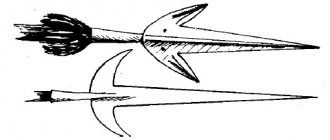

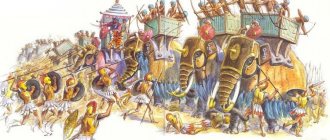
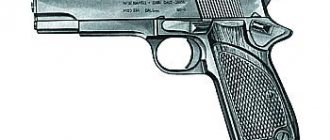
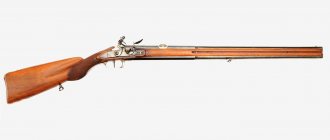
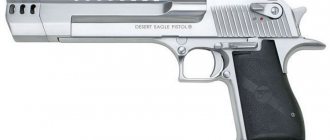
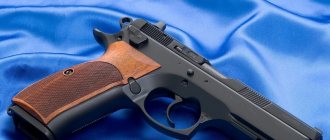
!['Domestic small arms [studio "Wings of Russia"] (2011)'](https://knifesburg.ru/wp-content/uploads/otechestvennoe-strelkovoe-oruzhie-studiya-krylya-rossii-2011-330x140.jpg)
